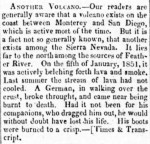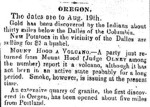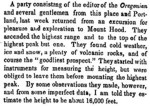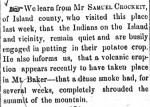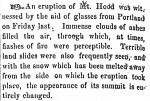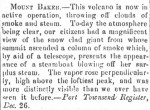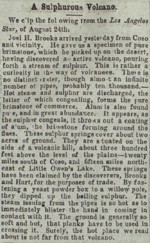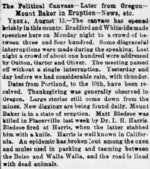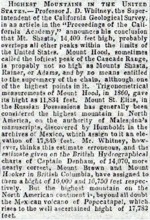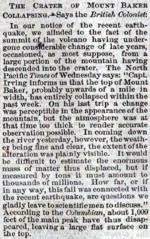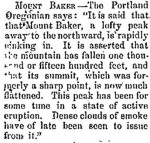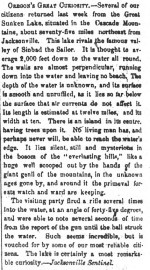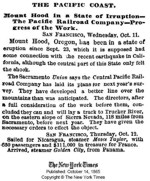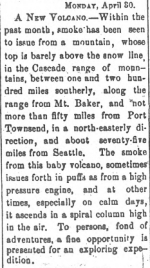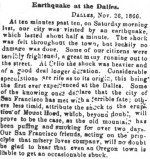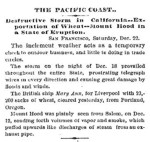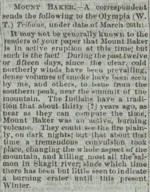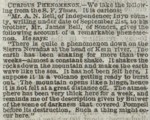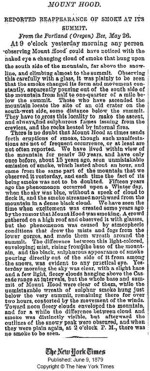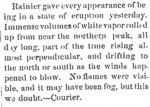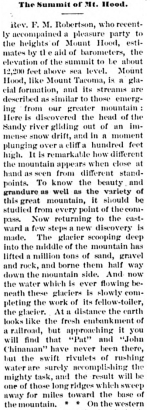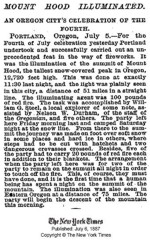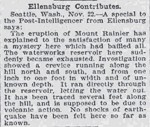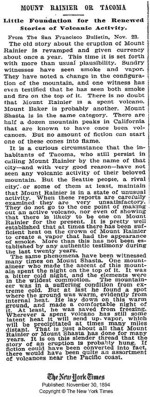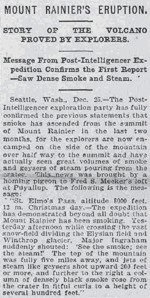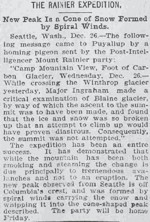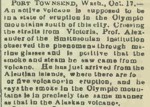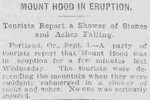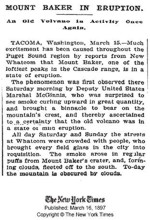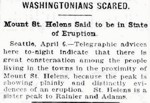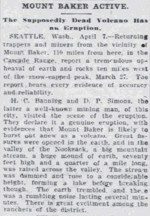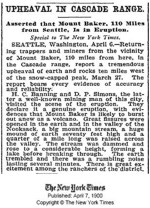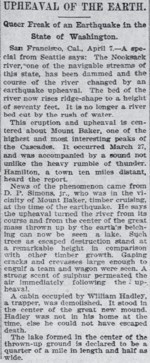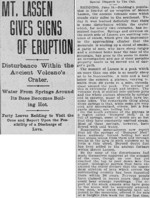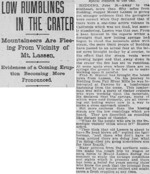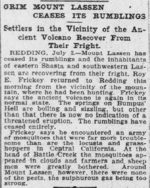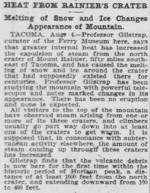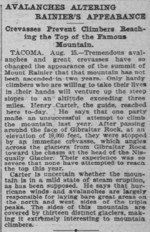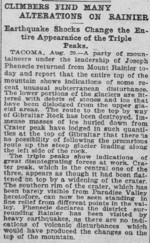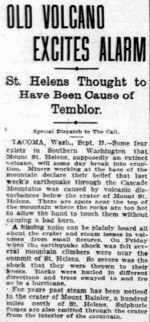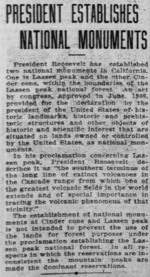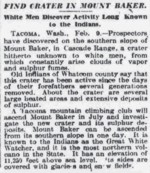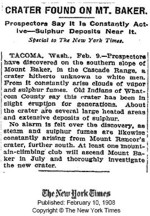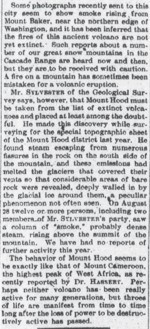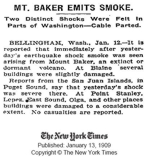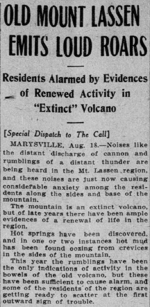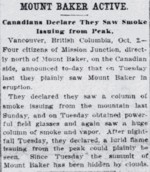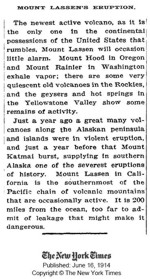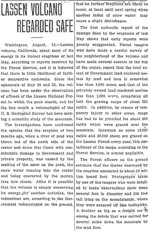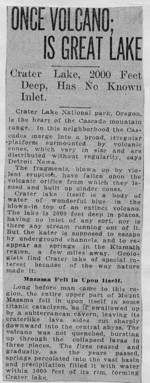Cascade Range Volcanoes
|
|
Please Note:
This list is by no means complete, and is simply
a collection of clippings found from the 1800s to early 1900s with references to volcanic eruptions, ascents, or descriptions of the Cascade Range volcanoes. Please keep in mind these "reports" of eruptions may not, infact, be eruptions at all, but may be a forest fire, avalanches, imaginations, or other such phenomena.
They are currently arranged by volcano and/or area, and then chronologically, with the earliest clippings for each volcano an/or area at the top.
[Back to Historical Timeline] |
|
December 25, 1852 ... mentioning eruption of 1850s, and January 5, 1851
Feather Lake, California The Columbian, Vancouver, WT.
|
|
September 3, 1853 ... describing ascent of August 26
First Ascent, Mount St. Helens, Washington which appeared in The Oregonian and The Columbian
|
|
September 26, 1854 ... covering events to August 19
Mount Hood, Oregon New York Times, September 26, 1854, as taken from the San Francisco Herald, covering events to August 19, 1854.
|
|
October 18, 1854
Mount Hood, Oregon New York Times, New York
|
|
November 11, 1854
Height of Mount Hood, Oregon Brooklyn Daily Eagle, Brooklyn, N.Y.
|
|
May 2, 1856
Mount Baker, Washington Pioneer And Democrat, Olympia, WT.
|
|
April 17, 1857
Mount St. Helens, Washington Washington Republican (Steilacoom), in article by Frank Balch
|
|
August 20, 1859 ... describing eruption of August 17, 1859
Mount Hood, Oregon Weekly Oregonian
|
|
August 26, 1859 ... describing eruption of August 19, 1859
Mount Hood, Oregon Pioneer And Democrat, Olympia, WT.
|
|
November 25, 1859
Mount Baker, Washington Pioneer And Democrat, Olympia, WT.
|
|
July 1860
Active Mount Baker and Mount St. Helens, Washington, with references to Mount Shasta, Mount Hood, Mount Rainier, Mount Jefferson, and Mount Adams Commonwealth, Des Moines, Iowa, as printed in Scientific American, July 21, 1860.
|
|
December 28, 1860
Mount Baker, Washington Pioneer And Democrat, Olympia, WT.
|
|
September 18, 1861
Coso, California Deseret News, Utah
|
|
August 14, 1863
Mount Baker, Washington Daily Alta, San Francisco, August 14, 1863
|
|
September 7, 1864
Mount Shasta, California Deseret News, Utah
|
|
December 21, 1864
Mount Baker, Washington Deseret News, Utah
|
|
May 12, 1865
Mount Baker, Washington Union Vedette, Utah
|
|
September 2, 1865
Crater Lake, Oregon Seattle Weekly Gazette
|
|
September 29, 1865
Mount Hood, Oregon Walla Walla Statesman, Walla Walla, Washington
|
|
October 14, 1865 ... referring to September 23 - October 11
Mount Hood, Oregon New York Times, New York
|
|
October 26, 1865
Mount Hood, Oregon Deseret News, Utah
|
|
February 16, 1866
Three Sisters, Oregon Seattle Weekly Gazette
|
|
April 30, 1866
presumably Glacier Peak, Washington Puget Sound Weekly
|
|
November 21, 1866
Height of Mount Hood, Oregon Deseret News, Utah
|
|
November 30, 1866 ... referring to November 26
Mount Hood, Oregon Walla Walla Statesman
|
|
December 4, 1866 ... presumably referring to November 16, 1866
Mount Hood, Oregon Brooklyn Daily Eagle, Brooklyn, N.Y., taken from The Portland Oregonian
|
|
December 25, 1866 ... referring to December 12, 1866 ... (December 22)
Mount Hood, Oregon New York Times, New York
|
|
May 8, 1867 ... referring to March 26
Mount Baker, Washington Deseret News, Utah
|
|
October 1, 1867
presumably Mount Baker, Washington The New York Times, New York
|
|
October 16, 1867
Height of Mount Hood, Oregon Brooklyn Daily Eagle, Brooklyn, N.Y.
|
|
October 21, 1868
Inyo, California Deseret News, Utah
|
|
November 4, 1868
Inyo, California Deseret News, Utah
|
|
March 10, 1871
Mount Rainier, Washington Brooklyn Daily Eagle, Brooklyn, N.Y.
|
|
March 30, 1871
Mount Baker, Washington The Weekly Argus.
|
|
January 30, 1872
Mount Hood, Oregon The New York Times
|
|
September 14, 1873
Mount Hood "Illuminated" The New York Times, New York
|
|
June 9, 1879 ... (May 26)
Mount Hood, Oregon The New York Times.
|
|
September 15, 1880
Near Mount Baker Ogden Standard Examiner, Utah
|
|
December 14, 1880 ... (December 13)
Mount Baker, Washington The New York Times, December 14, 1880.
|
|
January 25, 1881 ... (January 24)
Mount Baker, Washington The New York Times, January 25, 1881.
|
|
February 1, 1881 ... (January 31)
Mount Baker, Washington The New York Times, February 1, 1881.
|
|
March 20, 1881
Mount Baker, Washington Brooklyn Daily Eagle, Brooklyn, N.Y., taken from the San Francisco Dispatch to the St. Louis Globe-Democrat
|
|
April 8, 1882
Mount Rainier, Washington Spokan Times
|
|
August 11, 1883
Summit of Mount Hood, Oregon Spokane Falls Weekly
|
|
April 10, 1886 ... (March 29)
Mount Hood, Oregon, and Mount St. Helens, Washington The New York Times, New York
|
|
July 6, 1887 ... (July 5)
Mount Hood "Illuminated" The New York Times, New York
|
|
November 22, 1894 ... (November 21)
Mount Rainier, Washington Salt Lake Tribune, Utah
|
|
November 23, 1894 ... (November 22)
Mount Rainier, Washington Salt Lake Tribune, Utah
|
|
November 23, 1894 ... (November 22)
Mount Rainier, Washington Salt Lake Tribune, Utah
|
|
November 30, 1894 ... (November 23)
Mount Rainier, Washington New York Times, New York, as taken from the San Francisco Bulletin, November 23, 1894
|
|
December 22, 1894 ... (December 14)
Mount Rainier, Washington Deseret News, Utah
|
|
December 26, 1894 ... (December 25)
Mount Rainier, Washington Salt Lake Tribune, Utah
|
|
December 27, 1894 ... (December 26)
Mount Rainier, Washington Salt Lake Tribune, Utah
|
|
October 26, 1895 ... (October 17)
Olympic Mountains, Washington Deseret News, Utah
|
|
September 2, 1896 ... (September 1)
Mount Hood, Oregon Salt Lake Tribune, Utah
|
|
March 16, 1897
Mount Baker, Washington The New York Times, March 16, 1897.
|
|
April 5, 1898
Mount St. Helens, Washington The Seattle Post-Intelligencer, April 6, 1898, p.6, col.5
|
|
April 7, 1898 ... (April 6)
Mount St. Helens, Washington Salt Lake Tribune, Utah
|
|
June 4, 1898
Mount Rainier, Washington Deseret News, Utah
|
|
April 7, 1900 ... referring to March 27
Mount Baker, Washington The Evening Times, Washington, D.C., and The New York Times, New York.
|
|
April 8, 1900 ... (April 7)
Mount Baker, Washington Salt Lake Herald, Utah
|
|
May 4, 1900 ... (May 3)
Lassen Peak, California The San Francisco Call
|
||
|
May 4, 1900 ... (May 3)
Lassen Peak, California The Salt Lake Herald, Utah
|
||
|
May 5, 1900 ... (May 4)
Lassen Peak, California The Salt Lake Herald, Utah
|
||
|
May 6, 1900 ... (May 5)
Lassen Peak, California The San Francisco Call
|
|
September 2, 1900 ... (September 1)
Mount Baker, Washington Salt Lake Herald, Utah.
|
|
September 2, 1900 ... (September 1)
Mount Baker, Washington San Francisco Call
|
|
June 10, 1902 ... (June 9)
Mount Rainier, Washington The New York Times
|
|
June 15, 1902 ... (June 14)
Lassen Peak, California The San Francisco Call
|
||
|
June 17, 1902 ... (June 16)
Lassen Peak, California The San Francisco Call
|
||
|
July 4, 1902 ... (July 3)
Lassen Peak, California The San Francisco Call
|
|
August 5, 1902 ... (August 4)
Mount Rainier, Washington The San Francisco Call, California.
|
|
August 16, 1902 ... (August 15)
Mount Rainier, Washington The San Francisco Call, California.
|
|
August 21, 1902 ... (August 20)
Mount Rainier, Washington The San Francisco Call, California.
|
|
September 20, 1903 ... (September 19)
Mount St. Helens, Washington The San Francisco Call, California, p.44. (similar article also appeared in the Washington Times, September 21, 1903, p.9.
|
|
October 3, 1903 ... referring to eruption of September 15
Mount St. Helens, Washington The San Francisco Call, California
|
|
June 9, 1907
Lassen Peak and Cinder Cone, California The San Francisco Call
|
|
February 10, 1908 ... (February 8)
Mount Baker, Washington The Sun, New York, N.Y.
|
|
February 10, 1908 ... (February 9)
Mount Baker, Washington The New York Times, February 10, 1908.
|
|
November 2, 1908
Mount Baker, Washington, and Mount Hood, Oregon The Sun, New York, N.Y.
|
|
January 13, 1909 ... (January 12)
Mount Baker, Washington New York Times, New York, N.Y.
|
|
August 19, 1909 ... (August 18)
Lassen Peak, California The San Francisco Call
|
|
October 3, 1909 ... (October 2)
Mount Baker, Washington The Washington Herald, Washington, D.C.
|
|
June 2, 1914 ... (June 1, 1914)
Lassen Peak, California The New York Times, New York
|
|
June 16, 1914
Lassen Peak, California The New York Times, New York
|
|
June 18, 1914
Lassen Peak, California Washington County News, Utah
|
|
May 28, 1915
Lassen Peak, California Grand Valley Times, Utah
|
|
August 12, 1915 ... (August 10)
Lassen Peak, California Box Elder News, Utah
|
|
August 27, 1920
Crater Lake, Oregon Spokane Chronicle
|
If you have questions or comments please contact: GS-CVO-WEB@usgs.gov
2008 - 2011, Lyn Topinka
Return to: Volcanoes and History | CVO Home Page


